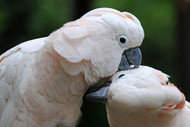Moluccan Cockatoo Fact Sheet
Posted by Moluccan Cockatoo Parrot, Moluccan Cockatoo Facts, Moluccan Cockatoo Behaviour, Moluccan Cockatoo Diet, Fact Sheets on 9/1/2024
Find out more about the Moluccan Cockatoo.
Scientific name:
Cacatua moluccensis
Common names:
Salmon-crested Cockatoo, Seram Cockatoo
Adult length:
52cm (21in). (Hand-reared birds often smaller.)
Adult weight:
About 900g but up to 1,050g.
Potential lifespan:
60 years
Click here for everything you need for Moluccan Cockatoos.
Status in wild:
Vulnerable. CITES Appendix I since 1989.

Reason
Excessive trapping of wild birds and to a lesser degree, deforestation. Listing it on Appendix I reduced the international trade but illegal trapping still occurs. More than 74,000 were exported between 1981 and 1990. Many of these were adult birds who were terrified of people and never adapted to captivity, resorting to self-mutilation, feather plucking and incessant screaming.
Origin
The island of Seram, Indonesia. For more information: please visit the website www.indonesian-parrot-project.org which describes the work being done to educate local people regarding the importance of this species, also rescue and rehabilitation of illegally trapped Moluccan Cockatoos.
Suitability as a pet
Highly unsuitable for 99.9% of Parrot owners. Unfortunately, young hand-reared Moluccan Cockatoos are often the subject of impulse buying. Can there be anything more sweet, vulnerable affectionate, cuddly and adorable than a young bird of this species? And can there be anything more difficult to control and to live with than an unhappy adult?
A suitable owner would be?
100% committed to providing a stimulating and loving environment for as long as he or she lives or is physically able to care for the bird.
One who understands the unpredictable temperament of this Cockatoo, this takes experience. A sudden wrong move that makes the bird over-excited could land you in an A&E hospital department with a very serious wound.
An attack from a Moluccan can be very sudden and unexpected if you cannot read their behaviour.
Able to tolerate ear-splitting screeches of a magnitude seldom encountered in the avian world.
Willing to love and care for the bird even when it is feather-plucked or self-mutilating.
Problems
Can there be anyone who reads Parrot magazines who is not aware of the fact that white Cockatoos, especially when hand-reared, are too demanding to make suitable pets? That is putting it mildly.
Many, perhaps even the majority, of these highly intelligent and (when young) irresistibly appealing birds, end up as unwanted or abused. They develop serious psychological problems that manifest themselves in problem behaviours such as biting, screaming and feather plucking.
On too many occasions I have received a telephone call from someone who has bought a white Cockatoo ? and is now paying the price. One lady told me: ?I have just bought a copy of your book The Loving Care of Pet Parrots. How I wish that I had read it before deciding to buy a Cockatoo. Everything you said has come true?!? In the book I warn about the demands of tame Cockatoos that cannot be met by those who go out to work.
Lady
She was not an unthinking lady who had carelessly embarked on buying a young hand-reared bird. This lady had wanted to do everything possible for her companion, who she loved dearly. She had even built an aviary in the garden so that when she was out her Cockatoo could play and exercise there. The problem was that she worked and when she returned home the Cockatoo screamed so much that, very reluctantly, she had to part with it. In fact, the breeder took it back. So already this young bird had lost its first home.
I believe that the majority of white Cockatoos spend less than three years at their first location and that period is numbered in just a few months for many individuals, especially those that have been hand-reared and, as usually happens, weaned too early.
Forced weaning has profound psychological effects on white Cockatoos. It makes them exceedingly anxious and clinging. They go on to become screamers, seed-flingers, pluckers and, in the worst scenario, self-mutilators (they gouge out areas of flesh, usually from the breast). I am not pretending that wild-caught Cockatoos never showed these traits but the incidence was lower.
Breeder
In the USA one breeder was asked to take back two of her hand-reared young from different owners ? a four-year-old Moluccan Cockatoo and an Umbrella.
She asked herself: ?What am I doing producing more hand-reared Parrots, when even perfect Parrots like Quinn and Woody, lose their families and their security, all they ever knew, because two people I thought were committed to them (not to mention each other), could not get along? ? I ask myself why I breed birds, given that so many are abandoned.?
She is not the only breeder faced with this dilemma. In the UK, a former Cockatoo breeder now devotes her time and energy to taking in unwanted Cockatoos. Breeders created the problem. If they have a conscience, they will stop breeding, or at least stop hand-rearing young, now that most rescue centres have run out of space for housing Cockatoos.
Breeders should speak to those few caring and dedicated people who rescue abused and abandoned Cockatoos and hear some of the terrible abuse and conditions suffered by these Cockatoos which in my opinion are too intelligent and too sentient to be in captivity. Their popularity is a tragedy for the species as a whole and for thousands of individuals.

If you have any comments about this article, please leave your thoughts for others below?
Find everything you need for Moluccan Cockatoos here.


